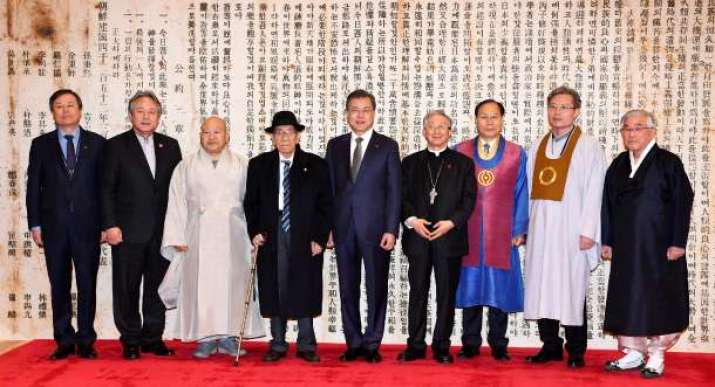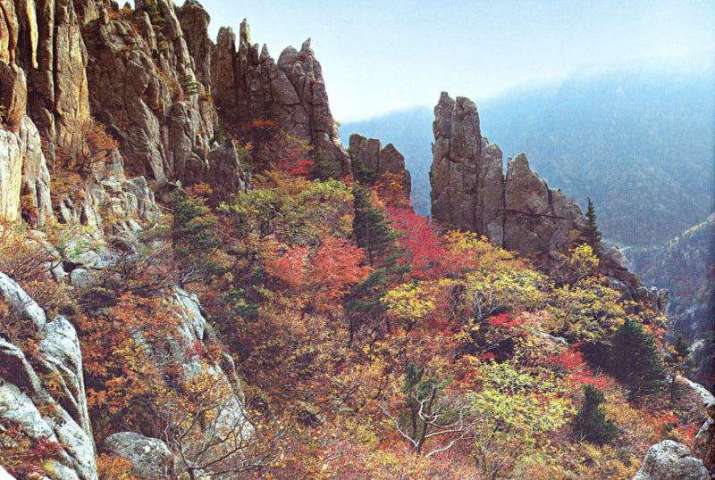
During a meeting with South Korea’s religious leaders yesterday, South Korean president Moon Jae-in said that a suspended tourism program to Mount Kumgang in North Korea will probably be the first inter-Korean project to resume once the two counties restart economic cooperation in the post-sanction era.
The tour and temple stay programs could help familiarize South Korean people with the North, he noted, while asking for the cooperation of the religious leaders.
“When we start economic cooperation between the South and the North, the easiest we can start will probably be the tours to Mount Kumgang, and if the temple stay (program) at Singye Temple could begin before the tours to Mount Kumgang can be resumed in a similar scale as that of the past, it will have the meaning of first reopening the path to Mount Kumgang,” Moon said on Monday. (The Korea Herald)
Last month, the Jogye Order of Korean Buddhism, South Korea’s largest Buddhist order, announced that it intended to explore options for overnight temple stays at Singye Temple on Mount Kumgang, just north of the inter-Korean border.* Moon, who supports the initiative, stated that he hoped the South Korea government would help the Jogye Order negotiate the plan with Pyongyang since temple stays could “open the path” to other tours to the iconic mountain.
Mount Kumgang is approximately 50 kilometers north from the South Korean city of Sokcho. It is one of the most famous mountains in North Korea and has been known since ancient times for its scenic beauty, being the subject of many works of art. The mountain is home to four renowned Buddhist temples: Singye Temple, Pyohun Temple, Jangan Temple, and Yujom Temple. Of the four, Singye Temple is often mentioned as an example of inter-Korean cooperation. The temple was completely demolished during the Korean War (1950–53) and then rebuilt and restored under a joint project with the help of the South Korean Buddhist community following the first inter-Korean summit in 2000.

The mountain was once the cornerstone of inter-Korean cooperation when it opened as a joint tour zone in 1998. Around 2 million South Koreans visited the region until tours were suspended after a 53-year-old South Korean female tourist was fatally shot by a North Korean guard in 2008.
Despite this ban on tours, Mount Kumgang continues to play an important role in inter-Korean relations. Just last week, a delegation of religious leaders, officials, and lawmakers traveled to the mountain for a two-day Lunar New Year event with their North Korean counterparts.
During the meeting, Moon noted that tours and other joint economic projects could only be restarted once UN sanctions tied to North Korea’s nuclear ambitions are lifted. He expressed the hope that North Korea’s denuclearization would continue to move forward after the second meeting between US president Donald Trump and North Korean leader Kim Jong-un, scheduled for next week.
“We expect to see great progress toward denuclearization [of North Korea] and normalization of North Korea-US relations from the second North Korea-US summit to be held next week,” the president told the meeting attended by the leaders of the nation’s seven major faiths, “It has been less than one year since the first inter-Korean summit. We are making such great progress in such a short period of time, and I believe the progress will continue in the future.” (The Korea Herald)
The meeting on Monday was held to commemorate the 100th anniversary of the March First independence movement, a series of demonstrations for Korean national independence from Japan that began in Seoul on 1 March 1919, and spread throughout the country. According to Moon, the 1919 movement was organized by 33 leaders and followers of different faiths, stating that he hoped that the faith leaders present at the meeting “would continue to lend [their] support so peace on the Korean Peninsula will lead to prosperity that benefits all.” (The Korea Herald)
The commemoration was the second that Moon has organized since taking office in May 2017. The first was held in December of that year.
* South Korean Buddhist Order Proposes Temple Stay Program in North Korea (Buddhistdoor Global)
Read more
Moon says Mount Kumgang tours will be first economic project with N. Korea (The Korea Herald)
Kumgang will be first to restart: Moon (Korea Joongang Daily)
Religious leaders, civic group officials visit N. Korea for new year event (The Korea Herald)













